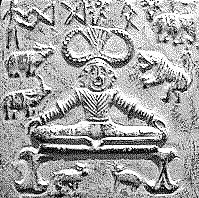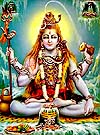The festival of Shivaratri
One of the prehistoric festivals of India is Shiva ratri, or night of Shiva.
 In various forms. the deity Shiva may be traced clearly right through the early historic age to the Indus civilisation : further back in mesolithic carvings on walls. Some feel shiva as lord of the animals or the hunt , is reflected even as far ago as the paleolithic. For instance the cave paintings found in many places in the world.
In various forms. the deity Shiva may be traced clearly right through the early historic age to the Indus civilisation : further back in mesolithic carvings on walls. Some feel shiva as lord of the animals or the hunt , is reflected even as far ago as the paleolithic. For instance the cave paintings found in many places in the world. In the people's tradition the stories and legends of Shiva are very popular all over India. They often reflect folk memories of a happy food gathering way of life--- living in hill forests, going on sprees, dancing and the like, remembrances of a time before settled agriculture and civilisation (--as we define it). The festival of Shiva Shivaratri also signifies the end of winter and arrival of spring.
On the day of Shivaratri all over India, the observances are similar. In most villages and less so in towns, people get up earlier than usual, take a bath preferably in a river or lake. Then they go to a shrine nearby, or at home set up a small linga which is just a small pillar. This symbolises Siva the ancient deity. Now, although various interpretations have been aired, this is certainly a tribal fertility symbol, and represents the male generative organ, as even the rig veda mentions. No need to explain away obvious facts. All human ancestors were cheerful tribal people once. Besides most festivals in India are affirmations of Nature anyway.
 The pooja, or service . The farmers and their families commence the rituals (pooja) in the usual manner of sprinkling water, offering flowers, leaves, incense , wave pieces of burning camphor on a plate (this process is called aarati), and so on while listening or repeating the formulae ( mantras). These are for the most part a collection in sanskrit of the titles of Siva, a type of index reference (pointers?) to the legends which everyone gathered there already knows. Actually few really understand the actual sanskrit, but the people's stories are popular and handed down the generations without editing or censoring.... whatever may be the hidden levels of meaning to people who can recognize the insights, they are highly interesting, humorous and entertaining and no doubt strike a deep chord, else would not have survived to this day. (ed--searching for good hyper links).
The pooja, or service . The farmers and their families commence the rituals (pooja) in the usual manner of sprinkling water, offering flowers, leaves, incense , wave pieces of burning camphor on a plate (this process is called aarati), and so on while listening or repeating the formulae ( mantras). These are for the most part a collection in sanskrit of the titles of Siva, a type of index reference (pointers?) to the legends which everyone gathered there already knows. Actually few really understand the actual sanskrit, but the people's stories are popular and handed down the generations without editing or censoring.... whatever may be the hidden levels of meaning to people who can recognize the insights, they are highly interesting, humorous and entertaining and no doubt strike a deep chord, else would not have survived to this day. (ed--searching for good hyper links).
In the rituals, leaves of a forest tree Aegle marmelos ( bilva, maredu, wood apple) are used in the services. After the pooja is over they observe a fast. (This is a difference--usually after services in India people have a feast).
Remain awake on the night of Shiva
In the evening they generally go to a nearby temple where in the company of many others they listen to recitals of the legends and their meanings. They are supposed to remain awake the whole night. (Similar observance is seen in Islam too.)
Often the family visits a large temple -- the trip may take a few days. At such places the crowds are huge. There may be various temporary auditoria or stages erected all over the place. A regular fair or market springs up. In olden days people used to buy things which weren't available in the remote villages.
Today the market aspect is not very important, but it affords a chance to see old traditional dances, drama and other performing arts which are disappearing. Straight out of National Geographic, sort of.
In Andhra pradesh Siva temples are very important. It appears the ancient notions here was some form of saivism. This is to be expected anyway since there is a still a strong tribal element : besides there is a strong egalitarian streak in the reform activities which appealed to the bulk of people as a whole. Everyone is allowed inside Shiva temples. Even animals. For instance monkeys and bulls and dogs can roam inside shiva temples and no one will stop them. Doesn't quite fit into our modern notions of proper order and regulations and procedures, but from their reasoned point of view it makes sense. You can't keep Nature out of places affirming Nature.
Shrines to shiva are found all over India and if pagan culture is taken into account, fairly common all over the world. In Andhra Pradesh, there are important centres like Srisailam, Kalahasti, Kalesvaram, Keesara (close to Hyderabad) and many others. Several are tourist centres. While the places may be a bit crowded, people say the best time to visit them is during such festivals.
Will place pictures and a page on the keesara festival soon.
back to index of culture spots and events
© V Ramchandra Rao ..all rights reserved.
email : vramrao@yahoo add .com
 The pooja, or service . The farmers and their families commence the rituals (pooja) in the usual manner of sprinkling water, offering flowers, leaves, incense , wave pieces of burning camphor on a plate (this process is called aarati), and so on while listening or repeating the formulae ( mantras). These are for the most part a collection in sanskrit of the titles of Siva, a type of index reference (pointers?) to the legends which everyone gathered there already knows. Actually few really understand the actual sanskrit, but the people's stories are popular and handed down the generations without editing or censoring.... whatever may be the hidden levels of meaning to people who can recognize the insights, they are highly interesting, humorous and entertaining and no doubt strike a deep chord, else would not have survived to this day. (ed--searching for good hyper links).
The pooja, or service . The farmers and their families commence the rituals (pooja) in the usual manner of sprinkling water, offering flowers, leaves, incense , wave pieces of burning camphor on a plate (this process is called aarati), and so on while listening or repeating the formulae ( mantras). These are for the most part a collection in sanskrit of the titles of Siva, a type of index reference (pointers?) to the legends which everyone gathered there already knows. Actually few really understand the actual sanskrit, but the people's stories are popular and handed down the generations without editing or censoring.... whatever may be the hidden levels of meaning to people who can recognize the insights, they are highly interesting, humorous and entertaining and no doubt strike a deep chord, else would not have survived to this day. (ed--searching for good hyper links).  In various forms. the deity Shiva may be traced clearly right through the early historic age to the Indus civilisation : further back in mesolithic carvings on walls. Some feel shiva as lord of the animals or the hunt , is reflected even as far ago as the paleolithic. For instance the cave paintings found in many places in the world.
In various forms. the deity Shiva may be traced clearly right through the early historic age to the Indus civilisation : further back in mesolithic carvings on walls. Some feel shiva as lord of the animals or the hunt , is reflected even as far ago as the paleolithic. For instance the cave paintings found in many places in the world.